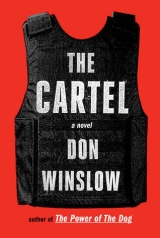
Текст книги "The Cartel"
Автор книги: Don Winslow
Жанр:
Криминальные детективы
сообщить о нарушении
Текущая страница: 40 (всего у книги 42 страниц)
3 The Cleansing
Wash me throughly from my wickedness and cleanse me from my sin.
–Psalm 51
San Diego, California
October 2012
A thousand years ago, Keller learns, the Petén was one of the most densely populated areas on earth.
As a center of the Mayan civilization, the heavily forested lowlands—rain forest, jungle—held dozens of cities with stone temples and courtyards, and vast terraced fields irrigated with canals, and chinampas, floating farms on lakes.
Then it went into decline.
No one is sure why, whether it was drought, or disease, or invasion, but by the time Cortés arrived in the 1520s the rain forest had taken back most of the towns and the farms, and what people survived the spread of the foreign smallpox lived off slash-and-burn agriculture in isolated villages.
Still, it took the Spanish almost two hundred years to finally and fully subdue the Mayan descendants in the Petén and set up a system of colonization that made the white Spanish and their mestizo offspring the landowning masters, and the native Mayan “Indians” the landless peasants.
The system held for almost four hundred years, even as the new American imperialists of the United Fruit Company came into power in Guatemala. It wasn’t until 1944 that the “October Revolutionaries” launched liberal reforms and in 1952 put through Decree 900 that mandated the redistribution of the land.
The masters reacted.
The 2 percent of the population that owned 98 percent of the land weren’t about to see their position altered and with CIA backing staged a coup that overthrew the civilian government.
The left—a loose coalition of students, workers, and a few peasants from the countryside—formed “MR-13,” a guerrilla movement that started to fight the Guatemalan army and police. After five years of sporadic fighting, the United States sent in its army special forces—the Green Berets—to help combat the “communist guerrillas.”
What followed was called the “White Terror” as the “Special Commando Unit” and the paramilitary Mano Blanca—actually police and soldiers—committed thousands of “disappearances” against leftists in Guatemala City and out in the countryside. Guatemala’s president, Carlos Arana Osorio, in declaring a “state of siege” announced, “If it is necessary to turn the country into a graveyard in order to pacify it, I will not hesitate.”
Seven thousand people “disappeared” over the next three years.
The left responded, forming the CUC (Committee for Peasant Unity) in the south and east and the EGP (Guerrilla Army of the Poor) in the Mayan north, and the Guatemalan Civil War went on.
If ever there has been a greater misnomer than “Mexican drug problem,” “Guatemalan Civil War” has to be it. Certainly it was a one-sided civil war, mostly the disappearances and slaughter of a few poorly armed leftist guerrillas by a professional army and police forces well supplied with American weapons and training.
In 1978 the special forces, the Kaibiles, opened fire on an unarmed group of protestors in Panzos and killed 150. By 1980, 5,000 had been killed.
Keller made it a point to study the history of a particular Guatemalan village in the Petén—Dos Erres.
It’s one of tragedy.
In October 1982, EGP guerrillas ambushed an army convoy near Dos Erres, killed twenty-one soldiers, and took nineteen rifles.
On December 4, a unit of fifty-eight Kaibiles disguised as guerrillas flew into the area. Two days later, they walked into the village at 2:30 in the morning. They roused the people from their houses and separated the men from the women, putting all the men into the village schoolhouse, and the women and children into the church. Then they searched the village for the missing weapons. They didn’t find any because the EGP who ambushed the soldiers hadn’t come from Dos Erres.
It didn’t matter.
The Kaibiles announced that after they’d had breakfast, they were going to “vaccinate” the inhabitants of Dos Erres.
The Kaibiles went berserk.
They grabbed children by the ankles and swung their heads into tree trunks and walls. Not wanting to waste ammunition, they smashed the adult men’s heads with hammers. They ripped babies from pregnant women’s stomachs, and then, over the course of the next two days, raped the rest of the women before killing them and dumping their bodies on top of their families in the village well.
On the last morning of the slaughter, fifteen more Mayan peasants wandered into Dos Erres. Because the wells were too full, the Kaibiles drove them half a mile away before slaughtering all but two teenage girls whom they raped as they left the area, then strangled them.
The Guatemalan “Civil War” went on for fourteen more years after the massacre of Dos Erres. Over two hundred thousand people were killed, including forty to fifty thousand who “disappeared.” A million and a half people were displaced from their homes, another million emigrated, mostly to the United States.
But the suffering of the Petén goes on, this time by narco cartels wanting the area for its proximity to the border. The Zetas and the Sinaloa cartel were ready to go to war for the Petén until Barrera brought Ochoa to the peace table.
Now Keller studies the latest satellite photographs.
The clearing outside Dos Erres is fresh, a small rectangle hacked out of the rain forest. He counts the number of tents and the two small buildings, but doesn’t have to do a calculation as to how many Gente Nueva are there. He already knows—Barrera has told him he was bringing a hundred men.
His intel team has done a calculation as to the numbers of Zetas, based on the small houses, huts, and tents in Dos Erres, the number of vehicles, and whatever satellite imagery they could grab of the village itself. Their best estimate was two hundred Zetas, among them maybe two dozen former Kaibiles.
We’re bringing twenty men, Keller thinks.
All elite operatives.
Keller has gotten to know and like the team members during the long weeks of training. It’s hard to get to know these men—they’re quiet, reticent, don’t swap biographies. The general, unspoken rule is that the less they know about each other the better, but Keller has gleaned that John Downey, “D-1,” the team leader, was an army full colonel, a Ranger with combat experience in Somalia, Iraq, and Afghanistan. Late forties, built like a fire hydrant, short red hair, pug nose, and an easy air of command.
It’s the only name he’s allowed to know. The rest are just first names—Keller has no idea if any or all are real—or nicknames. What they have in common is that they’re all professional, efficient, athletic, and educated. Through conversation over meals and beers he’s learned that most have advanced degrees in history, sociology, or the hard sciences and most are at least bilingual, but can curse fluently in English, Spanish (Downey recruited only Spanish speakers), Arabic, Kurdish, Pashto, and Dari.
Keller feels that he knows Dos Erres as well as you can know a place you’ve never been. He’s studied satellite photos, maps, and video. When the team moved from Virginia to a private training camp at Sunshine Summit, in remote hills about seventy miles north of San Diego, they built a mockup of the village with PVC pipe and cords.
They’ve practiced the operation a few hundred times.
Their best intelligence says that Ochoa has turned the empty church into his personal quarters, whereas Forty resides in the abandoned school just next to the church, on the west end of the village.
Each seems to have four personal bodyguards living in quarters with him, while the rest of the Zetas are quartered to the east of the village in the bivouac that had first been detected from the satellite reconnaissance.
A new clearing has been made to the west of the village. Another neat military rectangle, it has tents and what appear to be two C-containers that have been turned into living quarters, with small wooden porches covered with corrugated tin shade roofs.
Keller and the team have surmised that this new camp is for the Sinaloan guests, with the C-containers for Adán and Nacho.
The operational plan is simply but tightly timed.
Two MH-60 Black Hawk helicopters, each carrying ten men and a pilot, will fly the team across the Mexican border into Guatemala. The first chopper will hover over Dos Erres itself while its team fast-lines into the village and then separates into two “kill teams” of four men each. Kill Team “F” will attack the school and eliminate Forty. Kill Team “G” will hit the church and take out Ochoa. Downey will stay back with a medic who will double on communications.
The second chopper will land at the eastern edge of the village, along the narrow belt of jungle between the village and the Zeta camp. Its men will deploy and screen the kill teams from any counterattack coming from the camp.
There shouldn’t be one—the raid should be quick. Just in, just out, and then the first chopper will land, the kill teams will board, and then a fast “exfil” back across the border into Campeche, where the FES will pick them up and fly them to a military base outside Juárez.
From there they’ll “smurf” into small units, cross back into the States, and disappear.
The element of surprise will be critical.
Keller will be on Kill Team G with Eddie Ruiz. The special-ops guys didn’t really want Keller there; in fact, they wanted him to stay in the chopper. He’s too old, too slow, not a highly trained combat fighter, and there’s no time for him to catch up on the learning curve.
Keller told them to go fuck themselves.
“This is my op,” he told them. “I go, and I go in the front, or nobody goes.”
They grudgingly accepted it, more so as they learned more about “Killer Keller,” his background, and his personal losses. Rumors went around the camp about his relationship with the beautiful Médica Hermosa—who was promptly Googled and ogled—and how the Zetas shot her to pieces. The guys also learned about Erika Valles and Pablo Mora, and they decided that if Keller wanted to get some revenge, they were going to walk him in and take his back.
They’ve given him the radio call name “K-1.”
He surprised them in training.
Slow, yes, but precise.
And motivated.
And his briefings on the Zetas were comprehensive—their habits, their tactics, their training, their armaments—even the psychology of the two targets. He brought a treasure trove of photographs and video clips.
Eddie Ruiz brought something different.
Eddie was chilling out in his pad at Bliss when Keller came in and dismissed the babysitters.
“Pack,” Keller said.
“Where am I going?” Eddie asked.
“You’re coming with me,” Keller said. “To kill Forty and Ochoa.”
Eddie whistled. “Holy shit. That couldn’t have been easy.”
It wasn’t. Everyone and his dog had fought the idea of taking Crazy Eddie on the mission to Guatemala, but Keller argued that Ruiz was the only person who could personally identify both targets, that he was certainly a proven fighter, and that, at the end of the day, Ruiz was a free citizen who could walk out of Bliss anytime he wanted.
“We’d charge him five seconds later and arrest him,” Taylor answered.
“I promised him,” Keller said.
“You had no authority to do that.”
Keller shrugged.
“What if he runs?” Taylor asked.
“He won’t.”
Keller knew that he’d prevail on the issue. Eddie was damaged goods now that PAN had lost the election.
“You take him,” Taylor said, “you bring him back.”
“Sure.”
Eddie’s briefings—if you can call them that—have been invaluable. Ruiz had sat down with Zetas, ate with them, talked with them, partied with them. He knows how they talk, how they think, how they react. Along with Keller, he’s the only one who’s fought them, who’s killed them.
The ex–special ops on the team were resistant to him, too—at first—looking on him as an undisciplined, drug-dealing, homicidal dirtbag. But once Eddie freely admitted that’s exactly what he was, they relented a little. And there was no question about one thing—Crazy Eddie could shoot the balls off a mosquito if mosquitoes had balls.
He told them so, and backed it up on the range.
So did Keller.
But the physical training, Keller has to admit as he studies the latest intel images, about killed him. The guys are right—he is too old and too slow. His legs and reflexes just won’t do what his mind tells them to do, and it’s infuriating. He’s in the best shape of his life, and exhausted. If there were two missions instead of one, he wouldn’t make it. This is his last operation.
The other thing that’s killing him is the waiting.
He waited for weeks, sweating out whether Barrera could even get the meeting with Ochoa. Then weeks more to learn where the location was going to be. Once they knew that, the tactical planning and training went into overdrive, but then it was more waiting to find out the exact date. When the date was established, there were five more days of excruciating tension to see whether it would actually come off.
Now it has, Keller thinks as he studies the photos.
Barrera is in Dos Erres.
The meetings are scheduled to begin in the late afternoon tomorrow.
They’ll go all day and into the night—at which point there will be a fiesta and partying, if everything goes well. There will be no more meetings the next day because by the time the sun comes up, the Zeta leaders will be dead.
Adán Barrera will be the undisputed patron.
And the pax narcotica can begin.
Because that’s the deal.
There will be one cartel trafficking drugs into the United States and we can all go back to playing the perpetual game of coyote and sheepdog along the border. Business as usual, and the gigantic trafficking and antitrafficking machines can grind on. Without me, Keller thinks.
In two days, I’m out of it.
Maybe less than that, he admits, if you die in Dos Erres, which is a very real possibility. Face it, they’re all right—you have no business coming on this mission, you’re the weakest link, probably the least skilled combatant on the ground. There’s a very good chance you won’t come back.
But what if I do? he asks himself.
What then? What next? What do you do with what’s left of your life? You can’t go back to Marisol, she doesn’t want you, so the happy retirement you pictured with her is out of the picture. You can’t go back to tending the bees—the monastery won’t have you, and besides, you’re not that guy anymore. That guy believed in the possibility of serenity and faith. The past seven years have beaten that out of you.
There is no such thing.
Not in this world, anyway.
So what are you going to do?
Take your pension, find a condo in Tucson, become that pathetic middle-aged guy you find at sports bars at two in the afternoon? Take up golf? Brew your own beer? Read the great books? Hang around until you get the bad biopsy and in the meantime try to convince yourself that you haven’t done what you’ve done, seen what you’ve seen, that your nightmares are the stuff of fantasy and not just a slightly more surreal depiction of your surreal life?
Maybe there are worse things than dying in Dos Erres.
They break up the camp in Sunshine Summit and go to the staging area in San Diego. Then it will be separate flights to Mexico City, on to Campeche, then into the chopper and across the border for “Operation XTZ.”
“Cross Out the Zetas.”
In his hotel room out by the airport, Keller sits on his bed with his phone in hand and thinks about calling Marisol. But what would he say? I miss you? Goodbye? Nothing he’s going to say will change anything, but he isn’t going to say that he’s changed his mind about going.
He doesn’t call.
Restless, he goes for a walk through the old neighborhood known as Little Italy. He used to come down here from his office in the old days, to get a sausage at Pete’s—now gone—or a good espresso at a place that he sees is now a Starbucks.
He turns up Columbia Street to Our Lady of the Rosary, built back in the ’20s to serve the Italian tuna fishermen who dominated the neighborhood. Keller used to come here often, for early morning Mass, to make confession, take communion, or just look at the frescoes in the back of the sanctuary.
The tuna fleet is long gone, the Italian fishermen with it.
The neighborhood is “hip” now—coffeehouses and nightclubs, new condo buildings. The Italian restaurants are expensive and cater mostly to tourists.
Keller stands outside the church and thinks about going in. It’s too late for Mass, but there might be a priest inside to hear confession.
But how much time could he have? Keller asks himself ruefully.
Bless me, Father, for I have sinned and sinned and sinned and sinned…
And I’m about to go commit (another) murder.
At least one.
Keller keeps walking.
He has no need of God, he decides, and God has no need of him.
The Petén District, Guatemala
October 31, 2012
Chuy kicks a soccer ball against the remnant of a stone wall he doesn’t know is Mayan in origin.
The jungle is full of such ruins and he doesn’t care. Chuy wanders across the old stone terraces that were once altars without knowing what he’s walking on, or his own connection to them, that they were places where victims were decapitated in sacrifices to the Mayan death gods. He does like the caves that permeate the forest, cracks in the limestone floor of the jungle into which he can crawl and hide, take a nap, or just lie and think.
Forty brought Chuy and his estaca down to Guatemala and it was his first time on an airplane. He hated the crowded heat of Guatemala City but felt better when they drove north across the broad grasslands and then into the jungle. It still feels too close and too green, but he’s starting to get used to it, even though he’s a little scared at night because the men who’d been there longer told him that there are jaguars and pumas, and crocodiles in the swamps outside the village.
The village itself is pretty empty, except for some women and girls the men keep to do the cooking and the cleaning, and some men to do the grunt work. Otherwise, they had killed the villagers or chased them out, so it’s pretty much just Zetas living there in an armed camp.
The men had offered Chuy a girl for his bed, but he didn’t want her because he remembered Flor talking about her childhood in the Petén and how the Kaibiles forced her family off their land. So he doesn’t want a girl because it would remind him too much of her and also because he wakes up in the night crying and sometimes he pisses the cot, so he likes to sleep alone.
Some nights he doesn’t even sleep in the tent, but crawls into one of the caves and pulls a sweatshirt around him and sleeps there, even though he’s afraid of the jaguars and the pumas, but he has a rifle and a pistol and a knife so he’s not too afraid, and anyway, he only sleeps in fits and starts because in his sleep he sees faces—the faces of the boys who took him in the reformatory, the face of the first man he killed, the face of Forty, the face of Ochoa when he made him take the man’s head. He sees the faces of the people he’s killed, they’re like masks that float around the inside of his head when he closes his eyes.
Chuy sees the face of the woman police when he started to saw on her throat, and now he sees the face of the man they took away a few weeks ago, the drunk man who was so afraid and who cried and wept and begged and screamed until they shoved his shirt in his mouth to shut him up and he sees Forty’s face laughing, always laughing, telling him to do it, keep doing it, keep hurting him, you little bitch, you’re a little bitch, aren’t you.
And Chuy remembers his mission.
He kicks the ball into the wall hard and it bounces back to him and he juggles it on his foot twice before kicking it again. Maybe he should have been a fútbol player, maybe he should have done that instead of what he did, and it seems like a long time ago that he picked up that pistol and fired it into the air and they put him in jail.
Forty brought him down here to fight the Sinaloans, but now it turns out that they may not fight because Chuy has heard that Barrera himself is coming to sit down with Ochoa and make a deal and he wonders if that means he’ll stay in Guatemala or they’ll send him back to Mexico or even let him go home.
Maybe I’ll just stay here, Chuy thinks, and live in a cave. Hunt my food and live like they do on Survivor. Or go to Alaska like on one of those shows. Or maybe just walk into a shopping mall or a movie theater, open up with the erre and kill everybody.
See my face on television.
He kicks the ball against the wall again. It feels good, comforting, the simple repetitive action, and it keeps him absorbed until he hears the shout to “fall in.” He trots back to the center of the village where the men are forming up.
The word goes around quickly.
Adán Barrera is in Dos Erres.
–
Adán brings an army with him made up of a hundred of the best Gente Nueva, the ones who have been fighting the war in Juárez, Durango, and Sinaloa, and they’re well armed with assault rifles, grenade launchers, and enough ammunition to handle the situation if things go badly.
Nacho is there, of course.
He’d reached out across complicated layers of connections in the narco-world to get the message to Ochoa that they wanted to discuss peace. It seemed like a ludicrous proposition at the time, given the mutual carnage they were inflicting on each other across Mexico, but Nacho persisted with his trademark patience.
It helped that Ochoa was motivated—his recent European debacle was a major setback. The fighting on all fronts was at a stalemate, and no one could be sure what the new government was going to do.
The Zetas’ strongest card was their hold on the Petén, and Ochoa insisted that the meeting be there, not in Mexico, where Barrera’s tame federales, army, and FES could swoop in.
Nacho responded that the Petén was unacceptable, that they would have to find neutral territory in Colombia or even Europe, if it came to that, but Ochoa was adamant and Nacho finally gave in with the assurance that the Sinaloans were welcome to bring as much armed force as they wanted.
The sight of Dos Erres isn’t particularly reassuring, Adán thinks as they roll toward it in a convoy of jeeps and trucks. The place is the visual definition of a backwater—jungles and swamps and a virtually abandoned village.
The heat is oppressive, the humidity more so, the jungle tight and close, and the tension is bowstring taut. Fifty of his fighters are in front of him, fifty more behind as they drive along a dirt road guarded by Zetas dressed in paramilitary garb.
Every man in this parade is a blood enemy to the other side, with grudges, vendettas, and deep hatreds. A casual glance, an untoward word, a rumor. Anything could set if off before—
He doesn’t even let himself think it.
Nothing can be allowed to go wrong.
The convoy stops.
Adán knows it’s just a strict protocol being followed. He can’t meet Ochoa until Nacho meets with Forty. Their conversation takes only a few minutes and then the convoy is directed to a clearing about a quarter mile west of the village proper. The Zetas have chopped away the forest to create a campsite for their guests—tents have been set up and two cargo containers have been converted into living quarters for Adán and Nacho.
Adán’s men go into the camp first in case it’s an ambush, and check the grounds for booby traps and the dwellings for microphones. When they declare it clean, Adán’s jeep comes in and he takes possession of his “quarters”—the C-container with a bed and real mattress, a latrine, a sink, and, thank God, air-conditioning run off a generator.
He has a woman, clearly a local Mayan captive, for a servant. She looks terrified, and he smiles and does his best to reassure her as one of his men brings in his bags. His traditional black suit is clearly out of place here, and he changes into a clean white guayabera, jeans, and tennis shoes.
Reflecting that he hasn’t worn one of these shirts since his wedding, he thinks about Eva and the kids. At his insistence, they’ve all gone to the U.S. on a holiday while he’s away and should now be on the beach in La Jolla. The strange irony that they are under the protection of Art Keller is almost painful.
As is the knowledge that his own life might be in Keller’s hands.
The raid to kill the top Zetas is on for tomorrow morning—the peace meeting he arranged “locked the target in place,” to use Keller’s term. Now it’s just a matter of keeping Ochoa and Forty in place, lulling them into complacency with sweet talk of peace on favorable terms.
If everything goes well, Ochoa will be dead before the sun comes up.
Magda was pregnant, the autopsy had said.
With my child, Adán thinks.
He flops down on the bed to get a little rest before the meeting starts.
Outside, he hears a soft, odd thumping noise.
Rhythmic.
He doesn’t know what it is, and then realizes that someone is kicking a fútbol against a stone wall.
–
There are no jokes this time when Adán meets Ochoa.
No banter, no efforts to cut the tension. There’s only mutual hatred but also mutual need, and they sit down at the table quietly.
Armed men stand in an oval around them, out of earshot but within sight, their fingers on the triggers, their eyes on their opposite numbers. This could turn into a bloodbath in a second, Adán thinks.
Ochoa and Forty sit on one side of the table, Adán and Nacho on the other.
Z-1 has aged since the last time, Adán thinks.
The burden of command, I suppose. He’s just as handsome, but in a different way, and for the first time Adán can see the latent psychosis in his eyes. It’s disgusting sitting so close to him, talking peace with this sadistic killer, this mass murderer. The man is Satan, and his familiar Forty is, if anything, worse.
“Let’s get right down to work,” Nacho says.
Basically they agree on an east-west division of the plazas, which reflects the reality on the ground. Adán concedes that the Zetas will retain Nuevo León, Monterrey, and Veracruz, as well as Matamoros, Reynosa, and La Frontera Chica in Tamaulipas. In turn, Ochoa agrees that Tijuana, Baja, Sonora, and even Juárez, with the valley, will go to the Sinaloans.
The sticking point is Nuevo Laredo.
Adán puts up a fight, because to do otherwise would arouse suspicion. At first he demands the city outright, then offers to allow the Zetas to use it for a piso. Then he offers to discount the piso to three points.
It’s amusing, a small pleasure, to watch Ochoa get angry, and time and again Adán pushes him to the edge of calling off the negotiations, and then reels him back.
Finally, Nacho makes the proposal that they’d agreed upon beforehand. They’d revert back to the old days when the Floreses and the Sotos divided the plaza east and west. The Sinaloans would keep the western part of Nuevo Laredo, and the Zetas the east. That settled, Ochoa moves the topic to Europe and the relationship with ’Ndrangheta.
“I don’t know that I can help you there,” Adán says drily, making a point to smile at Forty. “ ’Ndrangheta shied away from you when you tried to do business with Islamic terrorists.”
“We need a piece of the European market,” Ochoa says.
It’s a risky topic because they all know it could bring up the subject of Magda Beltrán’s murder.
Adán lets it go. “Be that as it may…”
“You need our Gulf ports to do business in Europe,” Forty says.
“Not really,” Adán answers.
But he really does. It would be much more efficient to ship directly from Veracruz or Matamoros. He drags it out, but eventually pretends to reluctantly agree to Nacho’s suggestion that he “factor” Zeta cocaine to the Europeans in exchange for free use of the Gulf ports.
They break for lunch, an awkward hiatus over some mango and an execrable chicken dish.
There’s no small talk. They eat at separate tables, and Adán confers quietly with Nacho, then walks off to call Eva in La Jolla. The boys are fine, playing on the beach, she’s slathered them in sunblock, no they’re not too close to the water, yes, the North Americans are keeping close watch over them.
After lunch they tackle the subject of Guatemala.
It’s a deal-killer, Adán insists. Ochoa must share Guatemala. Sinaloan planes must have free access to landing strips and be allowed to transport their product across the border unmolested. They will, of course, pay their share of police and political protection.
Ochoa balks. Guatemala is his “by right of conquest”—which Adán finds amusing—and if the Sinaloans want to use the territory, they must pay for the privilege, and by the kilo. Adán gets up from the table. “Thank you for lunch. We won’t be requiring dinner.”
“Sit down.”
“Don’t tell me what to do.”
Nacho says, “Gentlemen—”
“If I pay you for every kilo of coke that I bring through Guatemala,” Adán says to Ochoa, “I might as well just go to work for you.”
“That would be acceptable.” Ochoa smiles.
Adán is growing tired of the game. But the game must be played, and on the chance that the raid doesn’t come off or fails, he needs an arrangement with the Zetas, so he says, “We’ve bled each other dry, it makes no sense to come to the peace table and try to bleed each other to death financially. I’m offering you a market in Europe in exchange for a supply route in Central America.”
Ochoa confers with Forty and then agrees.
What follows is a long, tedious discussion about security arrangements between now and the end of the present administration. Adán verifies that the AFI and the army will make no overt moves against the Zetas if they will not fire on agents or soldiers.
“What about the FES?” Ochoa asks.
“I have no influence there,” Adán says.
“Then why do they only come after us and not you?”
“Perhaps because you killed their families,” Adán suggests. Perhaps because you’re animals without the slightest restraint. Perhaps because you’re sociopaths and sadists. Perhaps because you crippled Keller’s woman and butchered a young woman he thought of as a daughter. Perhaps because you killed my unborn child. “I can’t help you there.”
Ochoa seems to accept it, and then asks, “What do you intend to do about the new administration?”








